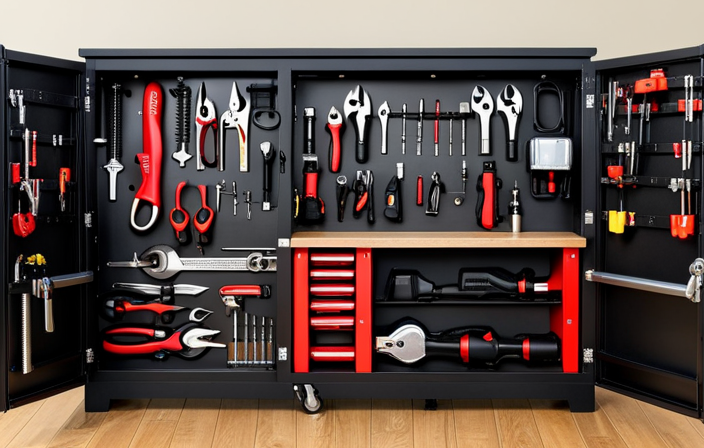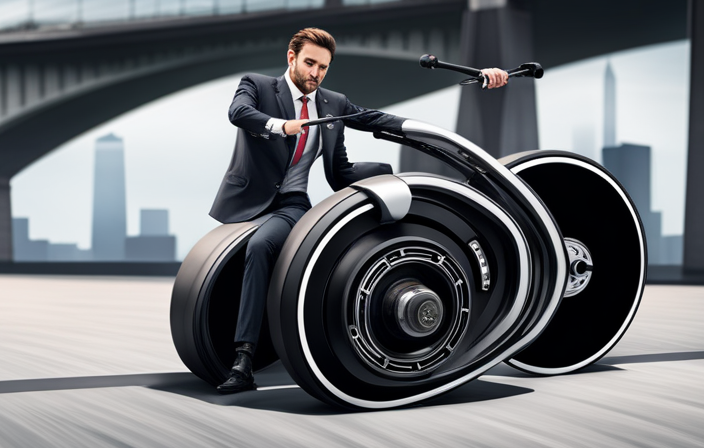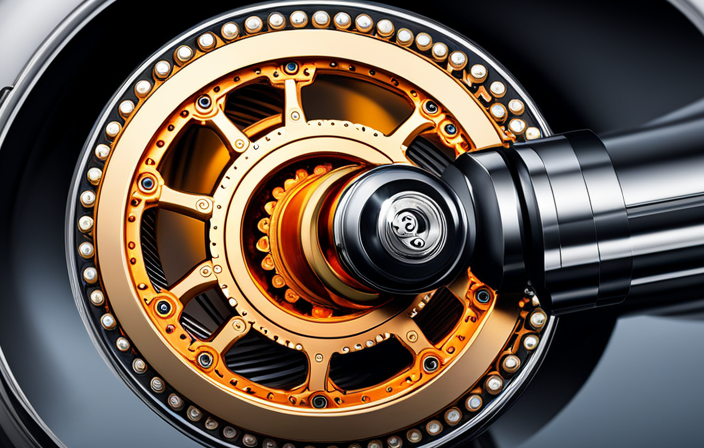As a seasoned electric bike enthusiast, I’ve come to realize that building your own electric bike is a thrilling endeavor.
But before you embark on this exciting journey, it’s crucial to have the right tools at your disposal.
In this concise guide, I’ll walk you through the essential tools you’ll need to assemble your electric bike with ease and precision.
From wrenches and screwdrivers to pliers and spoke wrenches, we’ll cover it all.
So, let’s dive in and unleash our inner bike builder!
Key Takeaways
- Wrenches, screwdrivers, Allen wrenches, and pliers are essential tools for electric bike assembly.
- A multimeter is an important tool for troubleshooting electric bike components.
- Wire strippers, electrical tape, and cable ties are necessary for wire preparation and connection.
- Additional tools such as a bike stand, grease or lubricant, and a spoke wrench are helpful for electric bike assembly.
Wrenches of various sizes
You’ll need wrenches of various sizes to assemble your electric bike. Proper torque settings are crucial when using wrenches to ensure that all the components are securely fastened without risking damage.
When assembling an electric bike, it is important to use the correct torque settings specified by the manufacturer for each specific component. This ensures that the bolts and nuts are tightened to the appropriate level, preventing them from coming loose during rides and reducing the risk of accidents or damage.
Different types of wrenches are used for different purposes in bike assembly. A socket wrench, for example, is commonly used to tighten or loosen nuts and bolts. An adjustable wrench, on the other hand, is useful for gripping and turning objects of various sizes. Additionally, a torque wrench is indispensable for achieving accurate torque settings.
Screwdrivers (both flathead and Phillips)
To assemble an electric bike, you’ll want to have both flathead and Phillips screwdrivers on hand. These screwdriver types are essential for attaching various components of the bike, such as the handlebars, seat, and pedals. The flathead screwdriver is characterized by a flat tip that fits into the corresponding slot on a screw, allowing you to tighten or loosen it. On the other hand, the Phillips screwdriver features a cross-shaped tip that fits into the corresponding slots on Phillips screws. This design provides better grip and prevents the screwdriver from slipping out while you’re working.
While flathead and Phillips screwdrivers are the most commonly used tools for bike assembly, there are alternative options available. For instance, some electric bike manufacturers provide specialized tools specifically designed for their particular models. These tools often have unique shapes and sizes that are tailored to fit specific screws and bolts used in the bike’s construction. Additionally, some bike enthusiasts prefer using electric screwdrivers or power drills with screwdriver attachments to speed up the assembly process.
Moving on to the next tool, let’s discuss the importance of allen wrenches in electric bike assembly.
Allen wrenches
Let’s talk about the importance of allen wrenches in assembling an electric bike. Allen wrenches, also known as hex keys, are indispensable tools for any DIY bike assembly project. Proper maintenance of these wrenches is crucial to ensure smooth and efficient assembly. It is important to keep them clean and free from any dirt or debris that may affect their performance. Regularly inspecting the wrenches for any signs of wear or damage is essential to prevent stripping or rounding of the bolt heads.
When using allen wrenches to assemble an electric bike, there are a few tips that can help ensure a successful and hassle-free experience. First, make sure to choose the correct size allen wrench for each bolt to avoid damaging the bolt or the wrench. Apply steady and even pressure while turning the wrench to prevent slipping and potential injury. Additionally, it is recommended to hold the wrench close to the short end for better control and leverage. Always tighten the bolts securely but avoid over-tightening, as this may lead to damage or premature wear.
Now, let’s move on to discussing the next essential tool for assembling an electric bike: pliers.
Pliers
When using pliers during the assembly process, it’s important to choose the right size for the task to ensure a secure and efficient connection.
Pliers are versatile tools that come in various types, each designed for specific uses. One common type is the slip-joint pliers, which can be adjusted to grip different sizes of objects. These pliers are great for holding and turning nuts, bolts, and pipes.
Another type is the needle-nose pliers, which have long, slender jaws that allow for precise maneuvering in tight spaces. These pliers are perfect for gripping and bending small wires and components.
Additionally, there are also cutting pliers, which have sharp cutting edges for snipping wires and cables cleanly.
By using the right type of pliers for each specific task, you can ensure a secure and efficient connection in the assembly process.
Now, let’s move on to another essential tool for assembling an electric bike: wire cutters.
Wire cutters
When using wire cutters, make sure to choose a pair that is sharp and suited for cutting the specific type of wire you are working with. Proper wire cutting techniques are crucial for a successful electric bike assembly. The importance of using the right wire cutters cannot be overstated. Not only will they make your job easier, but they will also ensure clean and precise cuts, minimizing the risk of damaging the wires or compromising the electrical connections.
When selecting wire cutters for your electric bike assembly, consider the type and thickness of the wires you will be working with. Different wire cutters are designed for specific purposes, such as cutting through thin gauge wires or thicker cables. It is essential to choose a pair that matches the wire size and material, as using the wrong tool can result in frayed or uneven cuts. Additionally, look for wire cutters with a comfortable grip, as this will reduce hand fatigue during the assembly process.
Transitioning to the next section on multimeters, it is important to note that after cutting wires, you will need to test the electrical connections. A multimeter is an invaluable tool for this purpose, allowing you to measure voltage, resistance, and continuity. By using a multimeter, you can ensure that all the electrical components of your electric bike are functioning properly before finalizing the assembly.
Multimeter
To ensure accurate measurements, make sure you have a multimeter with a clear display and easy-to-use controls. A multimeter is an essential tool for anyone assembling an electric bike. It allows you to measure voltage, current, and resistance, which are crucial for troubleshooting common issues with electric bike components. With a multimeter, you can ensure the electrical safety of your bike by checking for any faulty connections or short circuits.
Let’s take a look at how a multimeter can help you troubleshoot common issues with electric bike components:
| Component | Measurement | Possible Issue |
|---|---|---|
| Battery | Voltage | Low battery charge |
| Motor | Resistance | Overheating |
| Controller | Current | Malfunctioning |
By using a multimeter to measure the voltage of your battery, you can determine if it needs to be recharged or replaced. If your motor is overheating, you can check its resistance to see if it’s within the recommended range. And if your controller is malfunctioning, you can measure the current it’s drawing to diagnose the issue.
Now that we understand the importance of a multimeter in troubleshooting electric bike components, let’s move on to the next essential tool: wire strippers.
Wire strippers
Now that we understand how to use a multimeter effectively, let’s move on to another essential tool for assembling an electric bike: wire strippers. Wire strippers are crucial for any electrical project, as they allow you to remove the insulation from wires without damaging the conductor within.
Proper wire stripping techniques are vital to ensure a secure and reliable connection. When using wire strippers, it is important to select the appropriate gauge size to match the wire you are working with. This prevents over-stripping that can expose too much conductor or under-stripping that leaves insulation on the wire. Additionally, applying too much force while stripping can lead to damaging the conductor or causing nicks and cuts in the wire, compromising its integrity.
Common mistakes to avoid when using wire strippers include pulling the wire too hard, which can result in stretching or breaking it, and not using the correct notch or gauge size for the wire being stripped. It is also essential to pay attention to the depth setting on your wire strippers to ensure consistent and accurate stripping.
Properly stripped wires are essential for the next step in our assembly process: securing the connections with electrical tape.
Electrical tape
Using electrical tape is a convenient way to secure and insulate wire connections. Electrical tape provides a strong and flexible hold, making it ideal for various applications in electrical work. Here are some key points to consider when using electrical tape:
-
Insulation: Electrical tape is primarily used to insulate wire connections, preventing electrical current from flowing to unintended areas and reducing the risk of electrical shocks or short circuits.
-
Color Coding: Electrical tape comes in different colors, allowing for easy identification and organization of wires. This is particularly useful when dealing with multiple wires and complex electrical systems.
-
Waterproofing: Electrical tape has waterproof properties that help protect wire connections from moisture, making it suitable for outdoor or damp environments.
-
Temporary Fixes: In emergency situations, electrical tape can be used as a temporary fix for damaged wires or insulation until a permanent solution can be implemented.
While electrical tape is a versatile tool, there are alternatives available for specific applications. In the next section, we will explore the use of cable ties in securing wire connections and managing cable bundles.
Cable ties
When organizing your wires, cable ties can be a practical solution for securing wire connections and managing cable bundles.
In bike assembly, different types of cable ties are used for various purposes. One common type is the nylon cable tie, which is versatile and widely used in securing cables to frames and other components. These ties are strong, durable, and resistant to environmental factors such as moisture and UV radiation.
Another type is the releasable cable tie, which allows for easy adjustments or removal without cutting the tie. This can be useful during the assembly process when you may need to make changes or modifications.
Additionally, there are self-locking cable ties that have a built-in mechanism for securing the tie once it is tightened.
When fastening cables with cable ties during electric bike assembly, it is important to ensure a secure connection. To do this, make sure the cables are properly aligned and tightened, and avoid over-tightening to prevent damage.
As we move on to the next section about the adjustable crescent wrench, it is essential to have the right tools for assembling an electric bike.
Adjustable crescent wrench
The adjustable crescent wrench is a versatile tool that can be used for a variety of applications. When it comes to assembling an electric bike, this tool is indispensable. Here are some discussion ideas about different types of adjustable wrenches and their uses, as well as tips for properly using an adjustable crescent wrench during bike assembly:
-
Combination wrench: This type of adjustable wrench has both an open-end and a closed-end. It is perfect for tightening or loosening nuts and bolts of various sizes.
-
Pipe wrench: Designed for gripping and turning pipes, this adjustable wrench has serrated jaws that provide a strong grip.
-
Adjustable spanner: Also known as an adjustable wrench, this tool is ideal for turning objects with hexagonal or square-shaped heads.
When using an adjustable crescent wrench during bike assembly, keep these tips in mind:
-
Make sure the wrench is properly adjusted to fit the size of the nut or bolt.
-
Always apply force in the direction that tightens or loosens the fastener.
-
Use the wrench with a firm grip to prevent slippage and potential injury.
With the adjustable crescent wrench in hand, it’s time to move on to the next section about the bike stand or workbench.
Bike stand or workbench
To properly assemble your electric bike, you’ll need a sturdy bike stand or workbench to securely hold the components in place. Choosing the right bike stand is crucial for the success of your assembly process. A bike stand provides stability and allows you to work on your bike at a comfortable height, reducing strain on your back and neck. There are different types of bike stands available, so it’s important to consider your specific needs.
If you have limited space, a foldable or portable stand might be the best option. For heavier electric bikes, a stand with a higher weight capacity is recommended. Look for stands with adjustable clamps or jaws that can accommodate various frame sizes. It’s also worth considering a stand with a rotating feature, as it allows you to access different angles for easier assembly and maintenance.
Now that you have your bike securely held in place, the next step is to ensure smooth operation and longevity. One important aspect of bike maintenance is the use of grease or lubricant.
Grease or lubricant
Now that we have discussed the importance of having a bike stand or workbench for assembling an electric bike, let’s move on to another essential item: grease or lubricant.
Using grease during the assembly process offers several benefits. First and foremost, it helps reduce friction between moving parts, ensuring smooth operation and preventing wear and tear. Additionally, grease provides a protective barrier against moisture and contaminants, extending the lifespan of the components.
When choosing the right lubricant for your electric bike, there are a few key tips to keep in mind. Firstly, opt for a grease specifically designed for bicycles, as they are formulated to withstand the unique demands of cycling. Look for a grease that is waterproof and has good temperature stability, as electric bikes can generate more heat compared to traditional bikes. It is also important to consider the specific components that require lubrication and choose a grease that is appropriate for those parts.
With the proper grease or lubricant in hand, you can ensure a smooth and efficient assembly process for your electric bike.
Next, we will discuss another essential tool: the spoke wrench, which is crucial for adjusting and tightening the spokes of your bike’s wheels.
Spoke wrench
Having a spoke wrench is essential for adjusting and tightening the spokes on your bike’s wheels. When it comes to tools for spoke adjustment, a spoke wrench is the most important one to have in your toolkit.
Spokes play a critical role in maintaining the structural integrity and overall performance of your bike’s wheels. They provide strength and stability, ensuring that the wheel remains true and can withstand the forces exerted during riding.
Proper spoke tension is crucial for a variety of reasons. First and foremost, it helps to evenly distribute the weight and load on the wheel, preventing any excessive stress on individual spokes. This reduces the risk of spoke breakage and helps to extend the lifespan of your wheels. Additionally, proper spoke tension ensures that the wheel remains true, meaning it spins in a straight and balanced manner. This is essential for a smooth and efficient ride, as any imbalance can cause vibrations and affect overall performance.
Now, let’s move on to the next tool in our assembly process: the chain breaker tool.
Chain breaker tool
The chain breaker tool is an essential tool for repairing and removing bike chains. As a cyclist, I understand the importance of proper chain maintenance to ensure smooth and efficient pedaling. Here are three common chain issues and troubleshooting techniques that I’ve encountered:
-
Chain alignment: Sometimes, the chain can become misaligned, causing it to skip or make noise while pedaling. To fix this, I use the chain breaker tool to remove the chain, realign it properly, and then reattach it to the bike.
-
Chain wear: Over time, the chain can stretch and wear out, affecting its performance. By using the chain breaker tool, I can easily measure the wear and determine if the chain needs to be replaced. If it does, I can remove the old chain and install a new one.
-
Chain breakage: Occasionally, a chain may break while riding, leaving you stranded. With the chain breaker tool, I can quickly remove the broken link and reconnect the chain, allowing me to continue my ride.
Transitioning to the subsequent section about the ‘pedal wrench,’ I rely on this tool to remove and install pedals on my bike without any hassle.
Pedal wrench
I always keep a pedal wrench in my bike repair kit for easy installation and removal of pedals. Proper pedal installation is crucial for a smooth and efficient ride. When pedals are not installed correctly, they can come loose or even fall off while riding, leading to accidents and injuries. Therefore, it is essential to use a pedal wrench to ensure a secure and tight fit.
The benefits of using a pedal wrench are numerous. Firstly, the design of a pedal wrench allows for optimal torque application, ensuring that pedals are tightened to the appropriate level. This prevents any chances of them becoming loose during rides. Additionally, a pedal wrench provides the necessary leverage to overcome the tightness of pedals, especially when they haven’t been removed for a long time. This makes the removal and installation process quick and effortless.
Furthermore, a pedal wrench is specifically designed to fit the narrow space between the pedal and crank arm. Its slim profile and long handle allow for easy access and maneuverability. This ensures that the pedal wrench can reach and engage with the pedal spindle securely, preventing any damage to the crank arm or pedal threads.
Frequently Asked Questions
How long does it typically take to assemble an electric bike?
Typically, the assembly of an electric bike takes around 2-4 hours, depending on your familiarity with the process and the specific model.
To troubleshoot common issues during assembly, it’s important to carefully follow the manufacturer’s instructions and consult online resources if needed.
Additionally, optimizing the performance of your electric bike can be achieved by ensuring proper alignment of components, checking tire pressure, and regularly maintaining the battery and electrical connections.
Are there any specific safety precautions that need to be followed during the assembly process?
During the assembly process of an electric bike, it is crucial to follow specific safety precautions to ensure a safe and successful build.
Some important assembly steps include wearing protective gear, such as gloves and safety glasses, to prevent injuries.
Additionally, it is essential to disconnect the battery and power source before starting the assembly to avoid electrical shock.
Following these safety measures will help ensure a safe and smooth assembly process.
What are some common mistakes to avoid when assembling an electric bike?
One common mistake to avoid when assembling an electric bike is not properly connecting the wires. It is crucial to carefully match the colors and secure the connections to prevent electrical issues.
Another mistake is overlooking the importance of torque specifications. Failing to tighten bolts and nuts to the recommended torque can lead to parts becoming loose or damaged.
Troubleshooting tip: If the bike doesn’t turn on, check the battery connections and ensure they are securely attached.
Are there any additional tools or equipment that may be helpful during the assembly?
Additional tools and helpful equipment can greatly aid in the assembly of an electric bike. Some useful tools to consider include a torque wrench for precise tightening of bolts, a cable cutter for clean and precise cable cuts, a chain tool for installing and removing the bike chain, and a pedal wrench for installing the pedals securely.
Other helpful equipment may include zip ties for cable management, grease for lubricating components, and a workstand for better accessibility and stability during assembly.
Can the assembly process be easily completed by someone with limited mechanical experience?
Yes, it’s possible to hire a professional to assemble an electric bike. They have the necessary expertise and tools to complete the assembly process efficiently.
However, if you prefer to do it yourself with limited mechanical experience, there are online tutorials and guides available that can assist you. These resources provide step-by-step instructions and helpful tips to ensure a successful assembly.
Conclusion
In conclusion, assembling an electric bike requires a toolbox filled with the right tools. Like a symphony conductor needs his baton to create harmonious melodies, these tools are the key players in the orchestra of bike assembly. From wrenches of various sizes to screwdrivers and Allen wrenches, each tool has its own role. Pliers and wire cutters add their finesse, while grease and lubricant keep the gears humming like a well-tuned instrument.
With a spoke wrench, chain breaker tool, and pedal wrench in hand, you’ll be the maestro of electric bike assembly. Effortlessly transforming parts into a powerful and efficient machine.
















